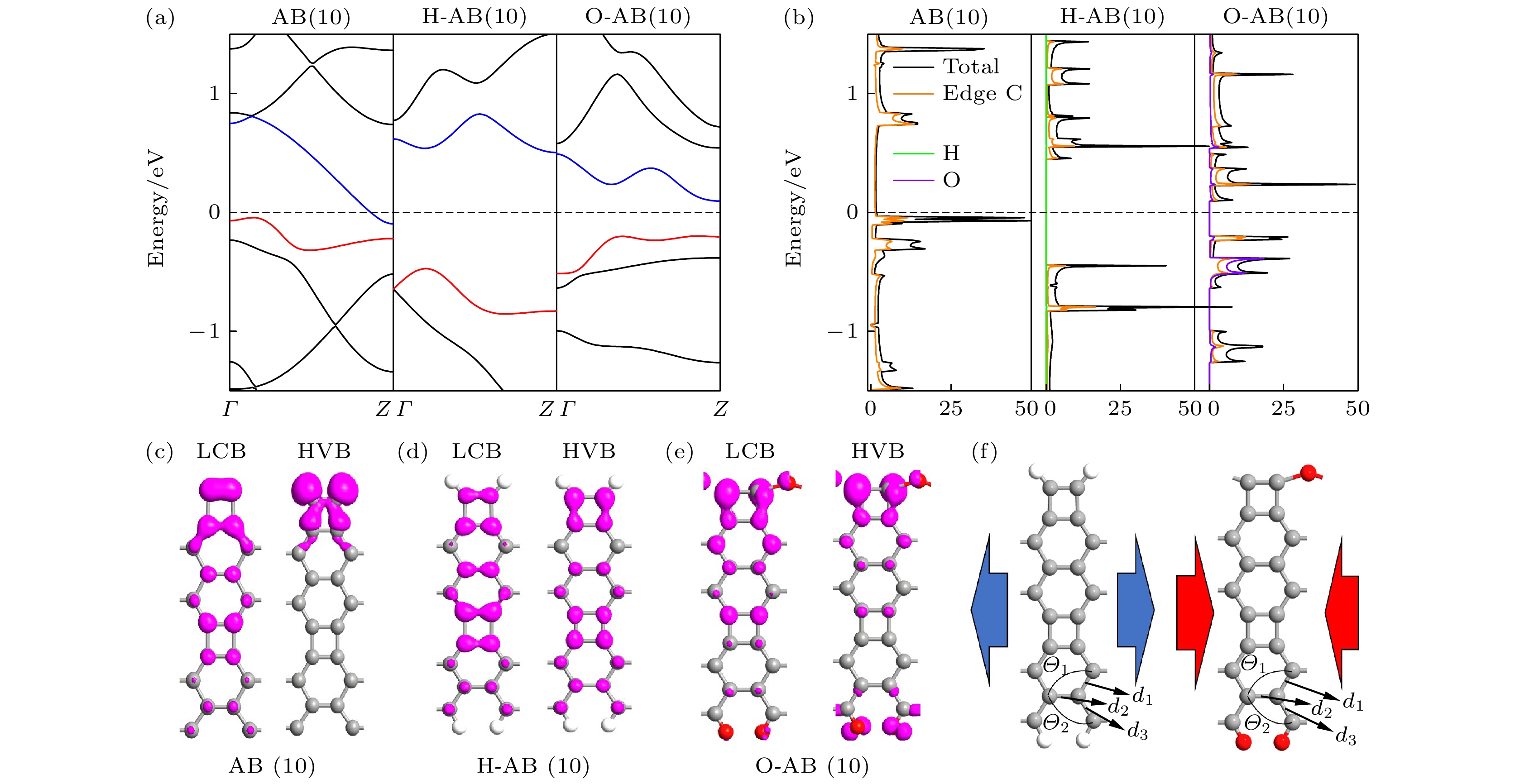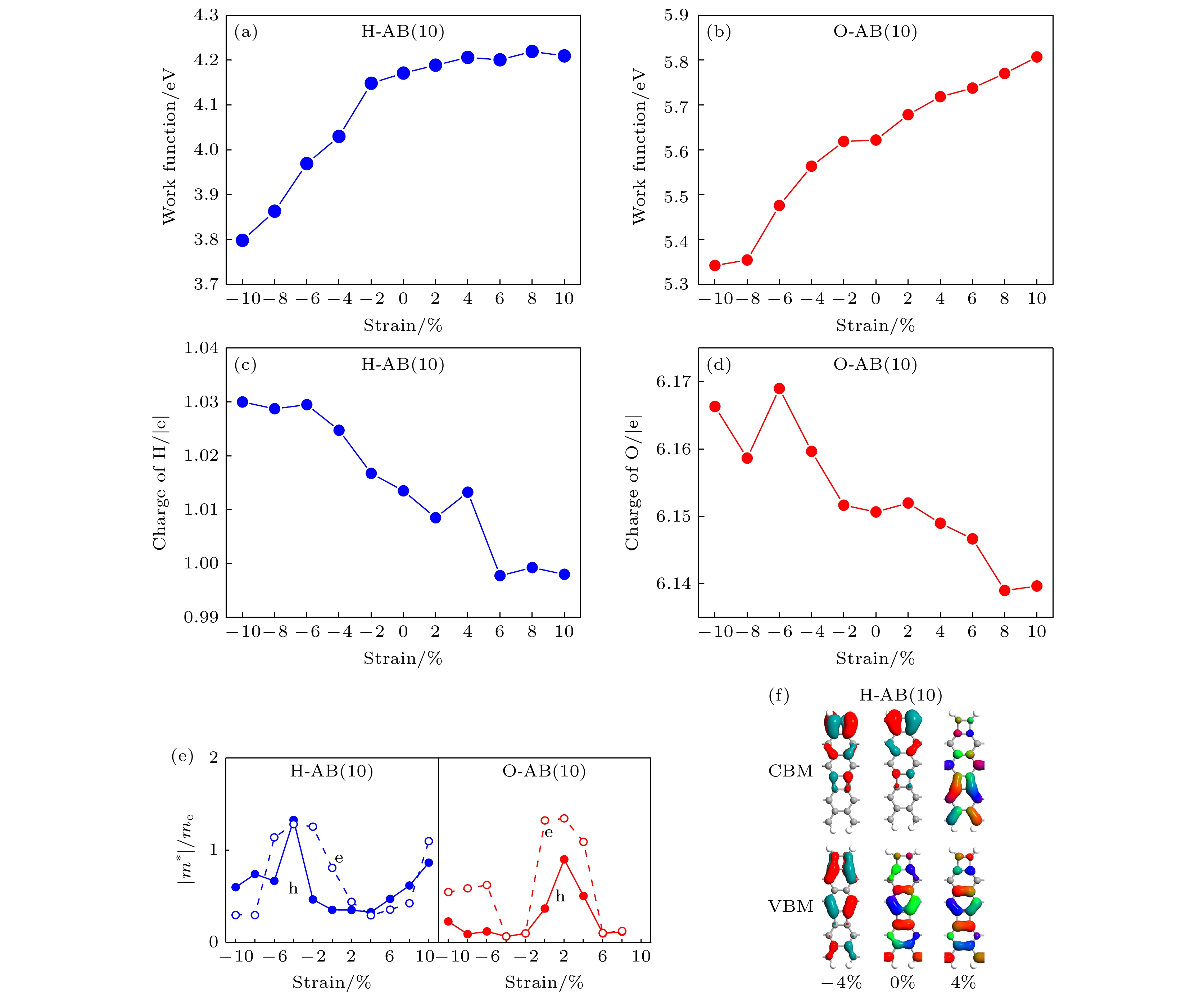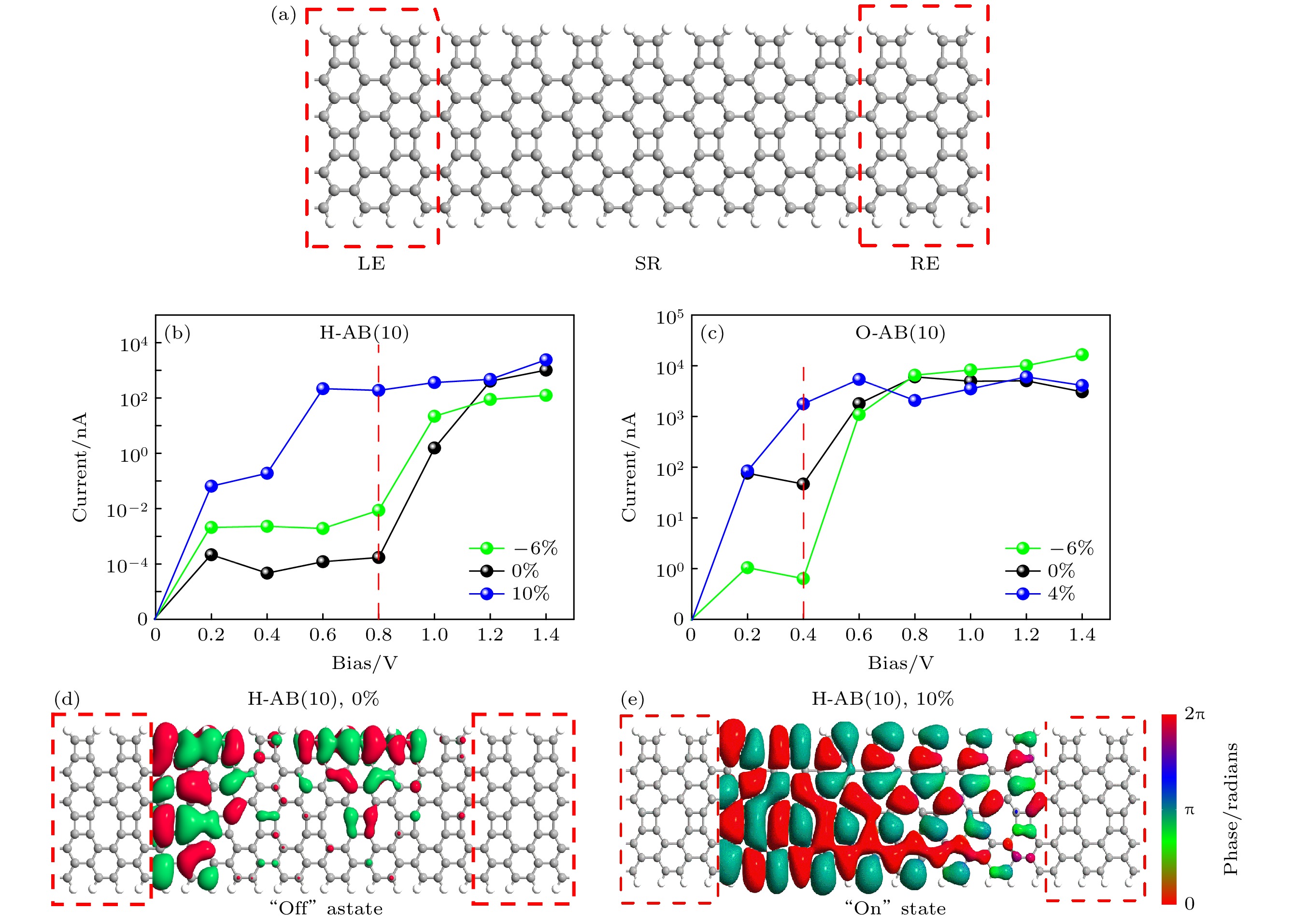-
利用密度泛函理论和非平衡态格林函数相结合的方法, 系统地研究了边修饰Net-Y纳米带的电子结构和器件特性的应变调控效应. 计算表明: 本征纳米带为金属, 但边缘的氢或氧原子端接能使其转变为半导体. 应变能有效地调控纳米带带隙的大小, 适当的应变使能带结构从间接带隙转变为较小的直接带隙, 这有利于光的吸收. 应变也能改变纳米带的功函数, 压缩应变能明显减小功函数, 这有利于纳米带实现场发射功能. 特别是应变能有效地调控纳米带相关器件的I-V特性, 能使其开关比(Ion/Ioff )达到106, 据此, 可设计一个机械开关, 通过拉伸及压缩纳米带使其可逆地工作在“开”和“关”态之间. 这种高开关比器件也许对于制备柔性可穿戴电子设备具有重要意义.Net-Y is a new two-dimensional carbon structure, which has attracted research interest recently. Here, we study the relevant AB-type ribbons with edge modification, focusing on their strain controlling effects on their electronic structure and device characteristics. Intrinsic ribbons are metallic, but hydrogen or oxygen termination can transform them into semiconductors. Applying strain can effectively control the band gap size, resulting in a transition from an indirect band gap to a smaller direct band gap under appropriate strain, favorably to light absorbing. Strain can also change the work function of ribbons, especially for compressive strains, the work function is lowered significantly, which is beneficial to the improving of the field emission behaviors of ribbons. The analysis demonstrates that the change in band gap size is closely related to the variation of bonding and non-bonding composition between atoms with strain, while the change of work function is due to the variation of the attraction force and repulsion force between atoms upon strain. More interestingly, the strain can significantly regulates the I-V characteristic of device based on related ribbons. Therefore, a strain-gated mechanical switch with a very high current switching ratio Ion/Ioff can be obtained by making it reversibly work between the “on” and “off” states with stretching and compressing ribbons, which is of great significance in developing the logic circuits for flexible wearable electronic devices.
-
Keywords:
- Net-Y nanoribbons /
- electronic properties /
- strain control /
- work function /
- mechanical switch
[1] Hirsch A 2010 Nat. Mater. 9 868
 Google Scholar
Google Scholar
[2] Novoselov K S, Geim A K, Morozov S V, Jiang D, Zhang Y, Dubonos S V, Grigorieva I V, Firsov A A 2004 Science 306 666
 Google Scholar
Google Scholar
[3] Fischer J, Trauzettel B, Loss D 2009 Phys. Rev. B 80 155401
 Google Scholar
Google Scholar
[4] Zeng YJ, Feng Y X, Tang L M, Chen K Q 2021 Appl. Phys. Lett. 118 183103
 Google Scholar
Google Scholar
[5] Yan Q M, Huang B, Yu J, Zheng F W, Zang J, Wu J, Gu B L, Liu F, Duan W H 2007 Nano Lett. 7 1469
 Google Scholar
Google Scholar
[6] Son Y W, Cohen M L, Louie S G 2006 Phys. Rev. Lett. 97 216803
 Google Scholar
Google Scholar
[7] Son Y W, Cohen M L, Louie S G 2006 Nature 444 347
 Google Scholar
Google Scholar
[8] Choi S M, Jhi S H, Son Y W 2010 Phys. Rev. B 81 081407
 Google Scholar
Google Scholar
[9] Pisani L, Chan J A, Montanari B, Harrison N M 2007 Phys. Rev. B 75 064418
 Google Scholar
Google Scholar
[10] Tang Y N, Chen W G, Wang Z W, Zhao G, Cui Y Q, Dai X Q 2020 Appl. Surf. Sci. 530 147178
 Google Scholar
Google Scholar
[11] Zhang S L, Wang N, Liu S G, Huang S P, Zhou W H, Cai B, Xie M Q, Yang Q, Chen X P, Zeng H B 2016 Nanotechnology 27 274001
 Google Scholar
Google Scholar
[12] Liu Y, Wang G, Huang Q S, Guo L W, Chen X L 2012 Phys. Rev. Lett. 108 225505
 Google Scholar
Google Scholar
[13] Liu Q, Li J, Wu D, Deng X, Zhang Z, Fan Z, Chen K 2021 Phys. Rev. B 104 045412
 Google Scholar
Google Scholar
[14] Li X Y, Wang Q, Jena P 2017 Phys. Chem. Lett. 8 3234
 Google Scholar
Google Scholar
[15] Zhang S H, Zhou J, Wang Q, Chen X S, Kawazoe Y, Jena P 2015 PNAS 112 2372
 Google Scholar
Google Scholar
[16] Aierken Y, Leenaerts O, Peeters F M 2016 Phys. Rev. B 94 155410
 Google Scholar
Google Scholar
[17] Wang Z H, Zhou X F, Zhang X M, Zhu Q, Dong H F, Zhao M W, Oganov A R 2015 Nano Lett. 15 6182
 Google Scholar
Google Scholar
[18] Malko D, Neiss C, Vines F, Gorling A 2012 Phys. Rev. Lett. 108 086804
 Google Scholar
Google Scholar
[19] Liu M Z, Liu M X, She L M, Zha Z Q, Pan J L, Li T, He Y Y, Cai Z Y, Qiu X H, Zhong D Y 2017 Nat. Commun. 8 14924
 Google Scholar
Google Scholar
[20] Rong J, Dong H C, Feng J, Wang X, Zhang Y N, Yu X H, Zhan Z L 2018 Carbon 135 21
 Google Scholar
Google Scholar
[21] Liu J W, Yu G T, Huang X R, Chen W 2020 2D Mater. 7 015015
[22] Wang Y H, Zhang K, Ren S L, Li C G, Huang X, Yang Z H 2019 Chem. Phys. Lett. 734 136733
 Google Scholar
Google Scholar
[23] Son Y W, Cohen M L, Louie S G 2006 Physical Review Letters 97 216803
[24] Wakabayashi K, Sasaki K, Nakanishi T, Enoki T, Technol S 2010 Sci. Technol. Adv. Mater. 11 054504
 Google Scholar
Google Scholar
[25] Wakabayashi K, Takane Y, Yamamoto M, Sigrist M 2009 New J. Phys. 11 095016
 Google Scholar
Google Scholar
[26] Zhao T, Fan Z Q, Zhang Z H, Zhou R L 2019 J. Phys. D:Appl. Phys. 52 475301
 Google Scholar
Google Scholar
[27] Niu L L, Fu H Y, Suo Y Q, Sun F, Wang S S, Zhang G P, Wang C K, Li Z L 2021 Physica E 128 114542
 Google Scholar
Google Scholar
[28] Fu H Y, Sun F, Liu R, Bi J J, Wang C K, Li Z L 2019 Phys. Lett. A 383 867
 Google Scholar
Google Scholar
[29] Hu J K, Zhang Z H, Fan Z Q, Zhou R L 2019 Nanotechnology 30 485703
 Google Scholar
Google Scholar
[30] Hu J K, Fan Z Q, Zhang Z H, Zhang H 2020 J. Phys. D:Appl. Phys. 53 485001
 Google Scholar
Google Scholar
[31] Brandbyge M, Mozos J, Ordejon P, Taylor J, Stokbro K 2002 Phys. Rev. B 65 165401
 Google Scholar
Google Scholar
[32] Taylor J, Guo H, Wang J 2001 Phys. Rev. B 63 245407
 Google Scholar
Google Scholar
[33] Fan Z Q, Zhang Z H, Yang S Y 2020 Nanoscale 12 21750
 Google Scholar
Google Scholar
[34] 李野华, 范志强, 张振华 2019 68 198503
 Google Scholar
Google Scholar
Li Y H, Fan Z Q, Zhang Z H 2019 Acta Phys. Sin. 68 198503
 Google Scholar
Google Scholar
[35] Datta S 1995 Electronic Transport in Mesoscopic System (Cambridge: Cambridge University Press)
[36] Xue Y, Ratner M A 2003 Phys. Rev. B 68 115406
 Google Scholar
Google Scholar
[37] Xue Y, Datta S, Ratner M A 2003 Chem. Phys. 281 151
[38] Landauer R 1970 Philos. Mag. 21 863
 Google Scholar
Google Scholar
[39] Zhang Z H, Guo C, Kwong D J, Li J, Deng X Q, Fan Z Q 2013 Adv. Funct. Mater. 23 2765
 Google Scholar
Google Scholar
[40] Li Z L. Bi J J, Liu R, Yi X H, Fu H Y, Sun F, Wei M Z, Wang C K 2017 Chin. Phys. B 26 098508
 Google Scholar
Google Scholar
[41] 孙峰, 刘然, 索雨晴, 牛乐乐, 傅焕俨, 季文芳, 李宗良 2019 68 178502
 Google Scholar
Google Scholar
Sun F, Liu R, Suo Y Q, Niu L L, Fu H Y, Ji W F, Li Z L 2019 Acta Phys. Sin. 68 178502
 Google Scholar
Google Scholar
[42] 索雨晴, 刘然, 孙峰, 牛乐乐, 王双双, 刘琳, 李宗良 2020 69 208502
 Google Scholar
Google Scholar
Suo Y Q, Liu R, Sun F, Niu L L, Liu L, Wang S S, Li Z L 2020 Acta Phys. Sin. 69 208502
 Google Scholar
Google Scholar
[43] Dong Q X, Hu R, Fan Z Q, Zhang Z H 2018 Carbon 130 206
 Google Scholar
Google Scholar
[44] Luo A Y, Hu R, Fan Z Q, Zhang H L, Yuan J H, Yang C H, Zhang Z H 2017 Org. Electron. 51 277
 Google Scholar
Google Scholar
[45] Souza F A, Amorim R G, Prasongkit J, Scopel W L, Scheicher R H, Rocha A R 2018 Carbon 129 803
 Google Scholar
Google Scholar
[46] Wang D, Zhang Z H, Deng X Q, Fan Z Q, Tang G P 2016 Carbon 98 204
 Google Scholar
Google Scholar
[47] Li Z L, Zou B, Wang C K 2006 Phys. Rev. B 73 075326
 Google Scholar
Google Scholar
[48] Yi X H, Liu R, Bi J J, Jiao Y, Wang C K, Li Z L 2016 Chin. Phys. B 25 128503
-
图 1 (a) 2维net-Y结构, 考虑沿x轴方向裁剪, 绿色标记为A型边缘, 蓝色标记为B型边缘; (b) H-AB(10)纳米带; (c) O-AB(10)纳米带; (d) 三种模型的ELF, 等值面取为0.2 |e| Å–3; (e)热稳定性BOMD模拟结果
Fig. 1. (a) 2D net-Y structure; (b) H-AB(10) nanoribbon; (c) O-AB(10) nanoribbon; (d) the ELF to measure the probability to find electrons in a certain space, the isosurface is set as 0.2 |e| Å–3; (e) BOMD simulation results for test thermal stability.
图 2 (a) 纳米带能带结构; (b) 纳米带态密度和投影态密度分布; (c)—(e) 纳米带LCB及HVB子能带的部分电荷密度, 等值面为0.05 |e| Å–3; (f) 纳米带拉伸及压缩应变示意图, d1, d2, d3及Θ1, Θ2为边缘键长及键角
Fig. 2. (a) Band structure; (b) the density of states and the atom-projected density of states; (c)–(e) the partial charge density of LCB and HVB, the isosurface is set as 0.05 |e| Å–3; (f) schematic of stretched and compressed nanoribbons. The bond lengths (angles) related to edge carbon atoms and their adjacent ones are marked as d1, d2, and d3 (Θ1 and Θ2), respectively.
图 3 (a), (b) 边修纳米带能带结构的应变调控效应; (c), (d) 边修饰纳米带带隙和应变能随应变变化; (e), (f) 边修饰纳米带边缘键长及键角随应变变化
Fig. 3. The band structure versus strain for H-AB(10) (a) and O-AB(10) (b); the band gap and strain energy under different strains for H-AB(10) (c) and O-AB(10) (d); the evolution of edge-atomic bond lengths and bond angles with different strains for H-AB(10) (e) and O-AB(10) (f).
图 4 (a), (b) 边修饰纳米带功函数随应变变化; (c), (d) 每一个H 和O外层平均电子数目随随应变变化; (e) 有效质量与应变变化关系; (f) H-AB(10)的VBM及CBM在几个典型应变值下的Bloch态, 等值面为0.1 |e| Å–3
Fig. 4. (a), (b) Work function of edge-modified nanoribbons under different strains; (c), (d) the average number of electrons for H and O atoms under different strains; (e) the effective mass versus strain; (f) the VBM and CBM Bloch states for H-AB (10) under several typical strains, the isosurface is set as 0.1 |e| Å–3.
图 5 (a) 基于边修饰纳米带的双探针器件模型; (b), (c) 器件的I-V特性; (d), (e) H-AB(10)器件在“开”和“关”态时费米能级上的透射本征透, 等值面为0.02 |e| Å–3
Fig. 5. (a) Two-probe device model based on edge-modified nanoribbons; (b), (c) the I-V characteristics of the devices; (d), (e) the transmission eigenstates at the Fermi level, the isosurface is set as 0.02 |e| Å–3.
-
[1] Hirsch A 2010 Nat. Mater. 9 868
 Google Scholar
Google Scholar
[2] Novoselov K S, Geim A K, Morozov S V, Jiang D, Zhang Y, Dubonos S V, Grigorieva I V, Firsov A A 2004 Science 306 666
 Google Scholar
Google Scholar
[3] Fischer J, Trauzettel B, Loss D 2009 Phys. Rev. B 80 155401
 Google Scholar
Google Scholar
[4] Zeng YJ, Feng Y X, Tang L M, Chen K Q 2021 Appl. Phys. Lett. 118 183103
 Google Scholar
Google Scholar
[5] Yan Q M, Huang B, Yu J, Zheng F W, Zang J, Wu J, Gu B L, Liu F, Duan W H 2007 Nano Lett. 7 1469
 Google Scholar
Google Scholar
[6] Son Y W, Cohen M L, Louie S G 2006 Phys. Rev. Lett. 97 216803
 Google Scholar
Google Scholar
[7] Son Y W, Cohen M L, Louie S G 2006 Nature 444 347
 Google Scholar
Google Scholar
[8] Choi S M, Jhi S H, Son Y W 2010 Phys. Rev. B 81 081407
 Google Scholar
Google Scholar
[9] Pisani L, Chan J A, Montanari B, Harrison N M 2007 Phys. Rev. B 75 064418
 Google Scholar
Google Scholar
[10] Tang Y N, Chen W G, Wang Z W, Zhao G, Cui Y Q, Dai X Q 2020 Appl. Surf. Sci. 530 147178
 Google Scholar
Google Scholar
[11] Zhang S L, Wang N, Liu S G, Huang S P, Zhou W H, Cai B, Xie M Q, Yang Q, Chen X P, Zeng H B 2016 Nanotechnology 27 274001
 Google Scholar
Google Scholar
[12] Liu Y, Wang G, Huang Q S, Guo L W, Chen X L 2012 Phys. Rev. Lett. 108 225505
 Google Scholar
Google Scholar
[13] Liu Q, Li J, Wu D, Deng X, Zhang Z, Fan Z, Chen K 2021 Phys. Rev. B 104 045412
 Google Scholar
Google Scholar
[14] Li X Y, Wang Q, Jena P 2017 Phys. Chem. Lett. 8 3234
 Google Scholar
Google Scholar
[15] Zhang S H, Zhou J, Wang Q, Chen X S, Kawazoe Y, Jena P 2015 PNAS 112 2372
 Google Scholar
Google Scholar
[16] Aierken Y, Leenaerts O, Peeters F M 2016 Phys. Rev. B 94 155410
 Google Scholar
Google Scholar
[17] Wang Z H, Zhou X F, Zhang X M, Zhu Q, Dong H F, Zhao M W, Oganov A R 2015 Nano Lett. 15 6182
 Google Scholar
Google Scholar
[18] Malko D, Neiss C, Vines F, Gorling A 2012 Phys. Rev. Lett. 108 086804
 Google Scholar
Google Scholar
[19] Liu M Z, Liu M X, She L M, Zha Z Q, Pan J L, Li T, He Y Y, Cai Z Y, Qiu X H, Zhong D Y 2017 Nat. Commun. 8 14924
 Google Scholar
Google Scholar
[20] Rong J, Dong H C, Feng J, Wang X, Zhang Y N, Yu X H, Zhan Z L 2018 Carbon 135 21
 Google Scholar
Google Scholar
[21] Liu J W, Yu G T, Huang X R, Chen W 2020 2D Mater. 7 015015
[22] Wang Y H, Zhang K, Ren S L, Li C G, Huang X, Yang Z H 2019 Chem. Phys. Lett. 734 136733
 Google Scholar
Google Scholar
[23] Son Y W, Cohen M L, Louie S G 2006 Physical Review Letters 97 216803
[24] Wakabayashi K, Sasaki K, Nakanishi T, Enoki T, Technol S 2010 Sci. Technol. Adv. Mater. 11 054504
 Google Scholar
Google Scholar
[25] Wakabayashi K, Takane Y, Yamamoto M, Sigrist M 2009 New J. Phys. 11 095016
 Google Scholar
Google Scholar
[26] Zhao T, Fan Z Q, Zhang Z H, Zhou R L 2019 J. Phys. D:Appl. Phys. 52 475301
 Google Scholar
Google Scholar
[27] Niu L L, Fu H Y, Suo Y Q, Sun F, Wang S S, Zhang G P, Wang C K, Li Z L 2021 Physica E 128 114542
 Google Scholar
Google Scholar
[28] Fu H Y, Sun F, Liu R, Bi J J, Wang C K, Li Z L 2019 Phys. Lett. A 383 867
 Google Scholar
Google Scholar
[29] Hu J K, Zhang Z H, Fan Z Q, Zhou R L 2019 Nanotechnology 30 485703
 Google Scholar
Google Scholar
[30] Hu J K, Fan Z Q, Zhang Z H, Zhang H 2020 J. Phys. D:Appl. Phys. 53 485001
 Google Scholar
Google Scholar
[31] Brandbyge M, Mozos J, Ordejon P, Taylor J, Stokbro K 2002 Phys. Rev. B 65 165401
 Google Scholar
Google Scholar
[32] Taylor J, Guo H, Wang J 2001 Phys. Rev. B 63 245407
 Google Scholar
Google Scholar
[33] Fan Z Q, Zhang Z H, Yang S Y 2020 Nanoscale 12 21750
 Google Scholar
Google Scholar
[34] 李野华, 范志强, 张振华 2019 68 198503
 Google Scholar
Google Scholar
Li Y H, Fan Z Q, Zhang Z H 2019 Acta Phys. Sin. 68 198503
 Google Scholar
Google Scholar
[35] Datta S 1995 Electronic Transport in Mesoscopic System (Cambridge: Cambridge University Press)
[36] Xue Y, Ratner M A 2003 Phys. Rev. B 68 115406
 Google Scholar
Google Scholar
[37] Xue Y, Datta S, Ratner M A 2003 Chem. Phys. 281 151
[38] Landauer R 1970 Philos. Mag. 21 863
 Google Scholar
Google Scholar
[39] Zhang Z H, Guo C, Kwong D J, Li J, Deng X Q, Fan Z Q 2013 Adv. Funct. Mater. 23 2765
 Google Scholar
Google Scholar
[40] Li Z L. Bi J J, Liu R, Yi X H, Fu H Y, Sun F, Wei M Z, Wang C K 2017 Chin. Phys. B 26 098508
 Google Scholar
Google Scholar
[41] 孙峰, 刘然, 索雨晴, 牛乐乐, 傅焕俨, 季文芳, 李宗良 2019 68 178502
 Google Scholar
Google Scholar
Sun F, Liu R, Suo Y Q, Niu L L, Fu H Y, Ji W F, Li Z L 2019 Acta Phys. Sin. 68 178502
 Google Scholar
Google Scholar
[42] 索雨晴, 刘然, 孙峰, 牛乐乐, 王双双, 刘琳, 李宗良 2020 69 208502
 Google Scholar
Google Scholar
Suo Y Q, Liu R, Sun F, Niu L L, Liu L, Wang S S, Li Z L 2020 Acta Phys. Sin. 69 208502
 Google Scholar
Google Scholar
[43] Dong Q X, Hu R, Fan Z Q, Zhang Z H 2018 Carbon 130 206
 Google Scholar
Google Scholar
[44] Luo A Y, Hu R, Fan Z Q, Zhang H L, Yuan J H, Yang C H, Zhang Z H 2017 Org. Electron. 51 277
 Google Scholar
Google Scholar
[45] Souza F A, Amorim R G, Prasongkit J, Scopel W L, Scheicher R H, Rocha A R 2018 Carbon 129 803
 Google Scholar
Google Scholar
[46] Wang D, Zhang Z H, Deng X Q, Fan Z Q, Tang G P 2016 Carbon 98 204
 Google Scholar
Google Scholar
[47] Li Z L, Zou B, Wang C K 2006 Phys. Rev. B 73 075326
 Google Scholar
Google Scholar
[48] Yi X H, Liu R, Bi J J, Jiao Y, Wang C K, Li Z L 2016 Chin. Phys. B 25 128503
计量
- 文章访问数: 5297
- PDF下载量: 60
- 被引次数: 0














 下载:
下载:




